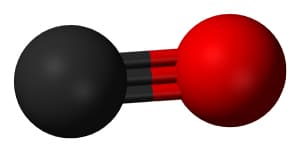
How It’s Used / Most Likely Means Of Exposure
Carbon monoxide (CO)—also known as Carbonic oxide and Carbon(II) oxide—is used in a host of industries, for dozens of applications. Some of the more common ones include fuel gas mixtures; chemical synthesis (organic acids, esters, alcohols, metal carbonyls); the reduction of ores; semiconductor manufacturing; and production of pharmaceuticals.
While a fairly large amount of CO is produced naturally, via photochemical reactions in the troposphere; volcanoes; and spontaneous forest fires; the most significant source affecting human health occurs from incomplete combustion of fuels. That is, insufficient oxygen is available to allow the reaction to complete to carbon dioxide.
Such incomplete combustion can occur in motor vehicles, power plants, and sundry industrial settings. Likewise, faulty heating systems and room space heaters can affect indoor occupancies, and are a hazard during cold weather.
Occupational Health/Toxicology
Exposure to carbon monoxide impedes the blood’s ability to deliver oxygen to body tissues and vital organs. When CO is inhaled, it combines with hemoglobin (in the red blood cells), producing carboxyhemoglobin (COHb), which greatly diminishes hemoglobin’s oxygen-carrying capacity.
Hemoglobin’s binding affinity for carbon monoxide is 300 times greater than its affinity for oxygen. In fact, certain pulmonary function instruments take advantage of this property, and so-called “lung diffusion” mixtures, containing 0.3% (3000 ppm) CO—along with 21% oxygen, and a neutral gas such as helium to measure the dilution factor—are supplied for this purpose.
As such, small amounts of carbon monoxide can dramatically reduce hemoglobin’s ability to transport oxygen. Common symptoms of CO exposure are headache, nausea, rapid breathing, weakness, exhaustion, dizziness, and confusion. Hypoxia (severe oxygen deficiency) due to acute carbon monoxide poisoning may result in reversible neurological effects, or it may result in long-term (and possibly delayed) irreversible neurological or cardiological effects.
High concentration CO exposures can be fatal, and still represent the leading cause of death due to poisoning in the United States. Sadly, virtually all these deaths are preventable.
Full record from Hazardous Substances Data Bank (HSDB), a database provided by the US National Library of Medicine.
The carbon monoxide entry from NIOSH’s Pocket Guide to Chemical Hazards.
Monitoring Instrumentation
Check out Interscan’s full line of carbon monoxide gas detection/gas monitoring instrumentation.
PowerPoint Presentation
Carbon monoxide monitoring—used in various training programs (5.7 MB)
